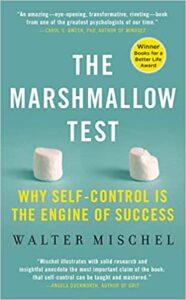Tips Stretch Focusing and Self-Control and Boost Kid Resilience
 New research shows that children who can pass up a marshmallow are more likely to succeed as adults as well as to thrive. But why? Here’s the secret every teacher and parent should know, and it started with a marshmallow.
New research shows that children who can pass up a marshmallow are more likely to succeed as adults as well as to thrive. But why? Here’s the secret every teacher and parent should know, and it started with a marshmallow.
In 1960, Walter Mischel, a psychologist at Stanford University, conducted the now famous marshmallow test. Mischel challenged a group of four-year-olds: Did they want a marshmallow immediately, or could they wait a few minutes until a researcher returned, at which point they could have two marshmallows? Mischel’s researchers then followed up on the children upon their high school graduation and found that those who had been able to wait for those marshmallows years before at age four now were far more socially competent: they were found to be more personally effective, self-assertive, and better able to deal with the frustrations of life. The third who waited longest also had significantly higher SAT scores by an average of two hundred points of the total verbal and math scores combined than the teens at four who couldn’t wait. Those results clearly revealed the importance of helping kids develop the ability to cope with behavioral impulses and learn self-control.StrentWaiti
Mischel, once a professor at Columbia, and a team researchers tracked those four-year olds. Hundreds of hours of observations have been conducted over the years on those participants. At first researchers figured that the children’s ability to wait just depended upon how badly they wanted the marshmallow. But it became apparent that every kid wanted the treat. Mischel now concludes that something else was helping those kids put on the brakes so they could delay their desire. The finding is a critical secret to success and here it is:
Those kids who were able to hold off and not eat the initial marshmallow could do so because they had learned a crucial skill that helped them wait.
The researcher calls that Waiting Ability or the “Strategic Allocation of Attention.” Jonah Lehrer described the self-control skill in an enlightening article entitled, “Don’t!: The Secret of Self-Control“ (which I strongly recommend you read).
Instead of getting obsessed with the marshmallow—the “hot stimulus”—the patient children distracted themselves by covering their eyes, pretending to play hide-and-seek underneath the desk, or singing songs from “Sesame Street.” Their desire wasn’t defeated—it was merely forgotten. “If you’re thinking about the marshmallow and how delicious it is, then you’re going to eat it,” Mischel says. “The key is to avoid thinking about it in the first place.”
That finding has enormous ramifications for our children’s social, academic and even moral success. But that waiting ability also enhances our children’s self-control which is highly correlated to improving resilience. Waiting enhances our children’s resilience.
Why We Must Teach Kids to Delay Gratification
But here’s the good news: Mischel and his colleagues believe that parents and teachers may be able to teach children skills that help them learn how to delay gratification and stretch their patience quotients. As Lehrer explains in that The New Yorker article:
“When he [Mishcel] and his colleagues taught children a simple set of mental tricks—such as pretending that the candy is only a picture, surrounded by an imaginary frame—he dramatically improved their self-control. The kids who hadn’t been able to wait sixty seconds could now wait fifteen minutes.”
“All I’ve done is given them some tips from their mental user manual,” Mischel says. “Once you realize that will power is just a matter of learning how to control your attention and thoughts, you can really begin to increase it.”
Meanwhile, research is currently under way in classrooms in which teachers are teaching students “waiting” skills and the preliminary results are promising. The real challenge will be to see if those newly-learned waiting skills can be turned into life-long habits–especially in this N.O.W. culture in which our kids have learned to expect instant gratification and reward, ASAP.
The findings of this research are too critical to overlook. Our first step is to start looking for those countless little everyday moments we can use to help our kids learn to put on the brakes. There are dozens of opportunities. Best ideas are always simple and can be used everywhere (at the grocery store, in the car, at Grandma’s in the classroom, on the soccer field). And then once you find one that works for you, use it over and over and over until it becomes a habit. Here are a few from Thrivers: The Surprising Reasons Why Some Kids Struggle and Others Shine.
1. Change the focus
Mischel found the more abstractly kids thought about the marshmallow, the longer they could delay. Teach one of these tips: “Focus on the least appealing part of the distractor.” “Don’t think about the taste but focus on its shape or color.” “Put a frame around the distrac- tor in your head, like a real picture.” (Those kids could wait almost eighteen minutes!)
2. Use mental diversions
Temptations can rob kids’ focusing abilities and decrease attention spans. Mischel discovered that when he taught kids easy mental tricks, their focus and self-control improved substantially. The trick is not to think about how delicious that marshmallow is but learn a distraction diverter. Ask your child:
“What will be the hardest part?” or “What’s the toughest thing to control? or “What would tempt you most?”
Temptations could be “Playing Fortnite instead of doing homework,” “Eating cake instead of dinner” or “Shooting baskets instead of doing my chores.” (Then hide the temptation!).
For younger kids you simply divert their attention. “Look at that bird on the tree!” “Count the number of peas on your plate!” “How many things can you find that start with a “B” in the room?
3. Stretch waiting time
Mary Budd Rowe, a noted educator, discovered that children need “wait time”—more time to think about what they hear—before speaking. So whenever you ask a question or give a request, remember to wait at least three seconds for your child to think about what she heard. The child will absorb more information, be more likely to respond, and probably give a fuller answer. That also means that during those three seconds you need to wait patiently, and continue to give your kid your full presence. Just to see how well you’re doing, the next time you ask your child a question, time yourself: How many seconds are you waiting until you get impatient for her immediate response? Stretch your waiting time.
Your child may barrel straight into every task right now, but your ultimate goal is to gradually stretch his ability to control those impulses and learn to wait at his level. Start by timing how long your child can pause before those impulses get the best of him. Take that time as his “waiting ability” -and then slowly increase it over the next weeks and months.
“Wait just a minute, Sweetie. Mom is on the phone.”
“I know you want a cookie, but you’ll have to wait ten minutes.”
“Sorry. We’re going to open presents after we have our dinner.”
“Nope. You get your allowance on Saturday. No loans until then.”
The secret is set your waiting expectations a bit longer than your child’s current waiting ability and then slowly stretch it without snapping it or giving in. (Think of a rubber band: “Stretch but don’t snap.”)
4. Play waiting games
Research shows that what a child learns to say to himself (or “self-instruction”) during the moments of temptation is a significant determiner of whether he is able to say no to impulsive urges and/or wait. Keep in mind that those kids who were able to hold off and not eat the marshmallows usually had learned a skill to help delay those urges. Here are six strategies from that help kids control impulses. Choose the one that works best for your child and then practice, practice, practice together until that new habit kicks in and he can use when he feels those impulses taking over.
- Freeze. In a calm voice say this to your child: “Freeze. Don’t move until you can get back in control.”
- Use a phrase. Have him slowly say a phrase like “One Mississippi, two Mississippi.”
- Hold your breath. Tell your kid not to breathe as long as possible and then to take a few long, deep breaths. (Just make sure he remembers to breathe!)
- Count. Join your child in slowly counting from on to twenty (or fewer with a youngre kid).
- Sing. For a young child, ask him to pick his favorite tune, such as “Frere Jacques” or “Twinkle Twinkle Little Star” and hum a few bars.
- Watch. Have him look at his wristwatch and count set numbers of seconds (such as ten). Expand that number to what is appropriate to the child.
 Of course, don’t stop here. There are dozens of ways to teach your child to wait and increase his self-control. The key is to find a strategy that works for your child, and then keep rehearsing it until your child can use it without you.
Of course, don’t stop here. There are dozens of ways to teach your child to wait and increase his self-control. The key is to find a strategy that works for your child, and then keep rehearsing it until your child can use it without you.
I’m excited to announce the release of my new book, Thrivers: The Surprising Reasons Why Some Kids Struggle and Others Shine on March 2! For forty years I’ve wondered why some kids have a strong, “We’ve got this!” attitude and discovered the science of resilience. Thrivers are made, not born. The book is packed with evidence-grounded strategies we can use to raise mentally and morally strong kids who are prepared to live and thrive in an uncertain world. I hope you like it!
For more ways to help children thrive, follow me on twitter @MicheleBorba, on my website: MicheleBorba .
Resources for this article”
Shoda, Y., Mischel, W., and Peake, P.K. “Predicting Adolescent Cognitive and Self-Regulatory Competencies From Preschool Delay of Gratification.” Developmental Psychology, Dec, 12, 1999, 26, (6), 978-86.
Lehrer, Jonah, “Don’t: The Secret of Self-Control,” The New Yorker, May 18, 2009.


